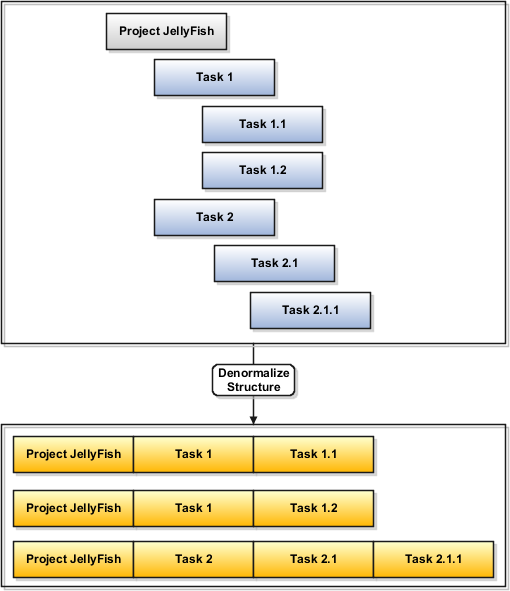How Task Structure Hierarchies Are Denormalized
Use the Denormalize Task Structure Hierarchies for Business Intelligence process to include the latest project data in Oracle Transactional Business Intelligence (OTBI) reports.
For example, you manage several projects and observe that actual costs on certain tasks aren't reported in OTBI reports. One of the reasons could be that you made changes to your project task structure and didn't denormalize the task structure.
Settings That Affect Task Structure Hierarchy Denormalization
When you manage projects using Project Financial Management applications, the task structure is denormalized when you first save the project plan. Subsequently, when you add, delete, move, or change the indentation of tasks, you can synchronize project updates from the project plan.
Alternatively, to ensure that OTBI reports are current, project application administrators and project managers can schedule the Denormalize Task Structure Hierarchies for Business Intelligence process to run on a regular basis. You must specify the following parameters.
-
Range of project numbers to include all active and approved projects with modified task structures.
-
The denormalization method.
-
Schedule for the process to run periodically.
Keep the following points in mind while specifying these parameters:
-
If you don't specify the project range in the From and To parameters, then the process runs for all the projects.
-
If you specify either the From or To parameter, then the process runs accordingly. For example, if you don't specify the To parameter, then the process runs for all projects starting from the project you specified in the From parameter.
-
Select Incremental as the denormalization method to skip the projects that were already denormalized and don't have any new changes in the task structure. Even if all the projects are considered for processing, only those projects that have changes in the task structure between the last execution and the current execution are denormalized.
How Task Structure Hierarchies Are Denormalized
The denormalization process groups hierarchical task data into single rows to reduce the number of task levels. The process creates a new row for each level of the hierarchy.
Example: Task Structure Hierarchy Denormalization
Project JellyFish has the following task hierarchy.
-
Task 1
-
Task 1.1
-
Task 1.2
-
-
Task 2
-
Task 2.1
-
Task 2.1.1
-
-
The following table and figure shows how the tasks appear after the denormalization process is run.
|
Level 1 |
Level 2 |
Level 3 |
Level 4 |
|---|---|---|---|
|
Project JellyFish |
Task 1 |
Task 1.1 |
|
|
Project JellyFish |
Task 1 |
Task 1.2 |
|
|
Project JellyFish |
Task 2 |
Task 2.1 |
Task 2.1.1 |
